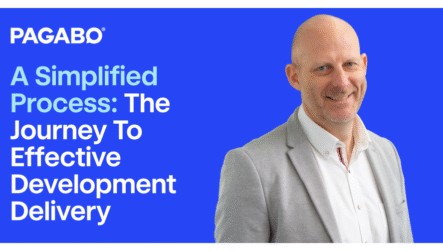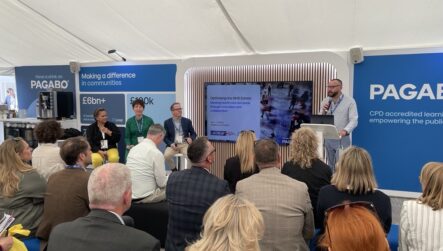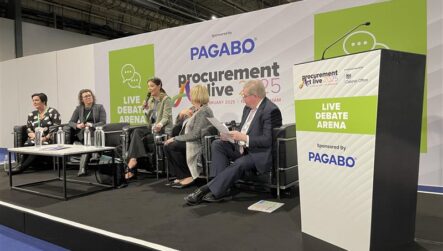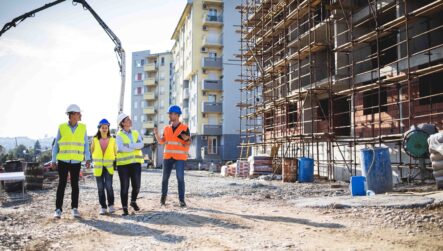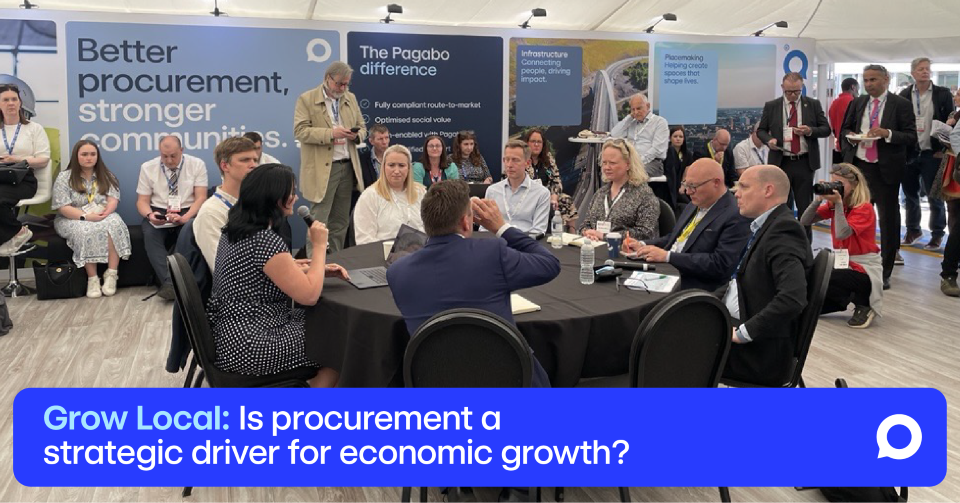
In an era defined by economic uncertainty, squeezed budgets, and urgent societal needs, local authorities are asking: how can we make every pound work harder – not just in balance sheets, but in communities?
Procurement is increasingly recognised not merely as a transactional function, but as a powerful lever for shaping places, communities and economies.
From regeneration schemes and infrastructure investment to housing developments and urban placemaking, the way councils and other public bodies procure services, suppliers, and contractors has a profound influence on economic inclusivity, community outcomes, and long-term local resilience.
At UKREiiF, we brought together a roundtable of local authority leaders, developers, and civic innovators on this topic. At the discussion’s heart was collective recognition that procurement is no longer just a back-office process – it’s one of the most powerful tools local government has for shaping places, supporting inclusive economic growth, stimulating local enterprise, and delivering long-term social value.
A platform for place-based growth
At its core, procurement in the built environment is about commissioning the physical assets that shape our towns and cities – schools, housing, transport, public realm, healthcare facilities, and more. But it also encompasses the strategic partnerships and supply chains that deliver these assets, maintain them, and ensure they serve the needs of diverse communities – now and into the future.
Every decision about who gets a contract to build a school, retrofit homes, or regenerate a town centre has downstream impacts – not only on local supply chains, but on skills pipelines, carbon outcomes, and ultimately the quality of life for local communities.
For too long, the sector has defaulted to the lowest-cost option – chasing short-term savings at the expense of long-term value. But the built environment sector has begun to challenge this mindset, embracing a ‘best value’ approach well before the new Procurement Act formally shifted the focus from MEAT (Most Economically Advantageous Tender) to MAT (Most Advantageous Tender).
All marks a critical shift towards considering the broader benefits, and for local authorities leading major regeneration, infrastructure and development schemes, this shift is especially significant. Whether commissioning a new town centre development or investing in active travel infrastructure, procurement can now be more explicitly designed to deliver against social, environmental, and economic objectives.
For local authorities, economic growth is now longer just a line in a strategic plan or a new tower crane in the skyline. Growth today means jobs that local people can access, communities that feel involved in shaping their own future, and businesses – particularly SMEs – that can thrive, not just survive.
This redefinition of growth puts people and place at the centre: it’s not just about what gets built, but who builds it, who benefits, and how long those benefits last.
Inclusion starts in the planning phase
We need to start by redefining what we mean by “growth.” For many local authorities, it’s no longer just about GVA (gross value added) or volume of development. Growth must be inclusive, people-centred, and capable of translating into better outcomes for residents.
Place leaders are increasingly reframing their investment strategies with these objectives in mind. For instance, city centre regeneration isn’t just about attracting footfall – it’s also about creating jobs, increasing housing supply, revitalising public space, and supporting local businesses to thrive. The measure of success is no longer just the delivery of assets, but the value those assets unlock over time.
But to put it simply – we can’t deliver for people and local businesses, if we don’t involve them in the process, making sure those already living in an area actively benefit from development works. Often, this is a group of people who can be the most sceptical about new developments, so making sure they see beyond the building site to the opportunities unlocked for them is crucial. To use the adage, the work starts at home.
The publishing pipeline required by recent procurement reform is going to be vital in supporting investment from those preparing to deliver schemes. This is where early engagement and inclusive procurement strategies become vital. By engaging communities in the early stages of planning and development and using procurement as a tool to embed social value into every stage of a project, authorities can ensure that benefits are not abstract, but truly tangible.
The best results come when procurement is treated as a design-led process. Early market engagement, soft market testing, and co-designed outcomes can help local authorities and suppliers alike better understand what’s needed, what’s possible, and how to align visions.
Leadership sets the tone
It’s easy to say procurement should drive social outcomes. It’s harder to hold the line when budgets are tight, or timelines are pressured.
Policy alone isn’t enough. What separates places making real impact is leadership – both political and operational – that sets the tone and holds the line on inclusive values. When social value is embedded into local plans, procurement strategies, and KPIs, it stops being an operational thing. It becomes the way things are done.
Too often, the gap between commissioning and delivery allows social value to slip through the cracks. Contractors may win bids based on ambitious social value promises, only for those promises to be lost in delivery. So, accountability mechanisms need to be built in using KPIs and measurement tools – monitoring not just what is delivered, but how, and whether the process has delivered the intended impact for local people and businesses.
SMEs and stronger supply chains
The built environment is dominated by a small number of large firms, particularly in Tier 1 contracting. Yet most businesses in the UK are SMEs – and they bring agility, innovation, and crucial local knowledge to the table.
Local authorities are increasingly recognising that engaging SMEs more effectively isn’t just about fairness – it’s a way to drive better outcomes. SMEs often contribute to their communities in ways that can go unrecognised: hiring locally, sponsoring local events, or mentoring young people. They may not use the language of “social value” – but they live it.
This is especially important in complex development projects, where a single master developer might subcontract out to dozens of smaller firms. Ensuring that the procurement pipeline is transparent and accessible allows smaller players to plan and participate more effectively.
The issue isn’t a lack of value – it’s a failure to translate between policy intent and frontline delivery. Something is getting lost in translation – so it’s time to reframe.
Better procurement, stronger communities
When local authorities and delivery partners commit to shared goals – whether that’s reducing NEET figures, supporting retrofitting skills, or enabling small businesses to flourish – procurement becomes a tool for transformation, not just transaction.
It’s not all about numbers and KPIs. If procurement truly has people at its heart, we should have pages of storytelling to report back – detailing how work has left a positive impact on individual people in the community. Every contract awarded is an opportunity to change a life: to create a job, build skills, support a business, enable better access to healthcare or education, or inspire a young person to rise to their potential.
This is the human heart of procurement. It’s what elevates the construction of a new health centre from a line item to a catalyst for health careers in disadvantaged communities. It’s what makes a town centre regeneration not just about footfall, but about civic pride and local prosperity.
Procurement is no longer the silent engine room of development – it’s the voice that can shape what kind of places we build – places where residents feel they belong. It’s about more businesses having access to opportunity, innovating and contributing to the local economy. It’s about more outcomes aligning with real community needs. And collaborative procurement is always advised to avoid unwarranted risk transfer that drives the wrong behaviours and increased costs to clients.
Frameworks: Extending capacity and accelerating impact
With many local authorities facing ongoing resource constraints, frameworks managed by agents like Pagabo are emerging as vital partners in helping deliver on ambitions for social value and inclusive growth.
Used well, frameworks aren’t just a shortcut to compliant procurement – they’re a strategic extension of internal capacity. They offer access to pre-vetted suppliers, streamlined routes to market, and expert support in areas such as contract structuring, social value evaluation, and supplier engagement.
Several participants noted that frameworks can also open up opportunities for smaller or specialist suppliers who may otherwise struggle to meet standalone tender requirements. When frameworks are designed with inclusion and place-based priorities in mind, they can help amplify local impact – particularly if local authorities collaborate to shape the scope and values of those frameworks together.
This also reinforces a broader shift: procurement isn’t just about what’s bought — it’s about how and why it’s bought, and who’s empowered in the process. Framework providers, when aligned to this mission, can help procurement teams turn ambition into action, even with limited in-house bandwidth.
So, can procurement be a strategic driver for economic growth?
Yes, but the true potential lies in the value being more than pounds and pence. Price and monetary returns will always matter, but value – in its fullest sense – matters more.
If we get this right, procurement becomes not just a route to savings, but a strategy for better places, opportunities for all, thriving communities, and shared success.
You can listen to the full recroding of the session by joining the Pagabo Live community today
Discover our frameworks

